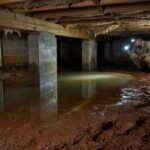Essential Guide to Foundation Repair: Signs Your Home Needs Immediate Attention
When it comes to homeownership, few things can be as disheartening as discovering that your house has foundation problems. You may think it’s the foundation of your home that needs repair; instead, it’s your very sanity that might need mending! But fear not, dear homeowner; we’re here to guide you through the essential signs that indicate your home requires immediate attention regarding its foundation.
Understanding Your Foundation
Your home’s foundation is essentially the unsung hero of the building structure. It supports everything above it and keeps your dwelling standing tall—just like a good pair of shoes that keeps you on your feet. Foundations can be made from different materials, including concrete, stone, or brick, and can be either slab-on-grade, crawl space, or basement foundations. No matter the type, when they start to fail, you’ll want to pay attention.
Why Care About Your Foundation?
Why should you care about your foundation? Well, a compromised foundation can lead to a myriad of issues, from plumbing problems to severe structural damage. In severe cases, the price of the repairs can escalate faster than a cat can climb a tree when startled. Addressing foundation problems early can save you a significant amount of money in the long run and preserve not only the value of your home but also your peace of mind.
Signs Your Foundation Needs Immediate Attention
1. Cracks in Walls and Floors
If you notice cracks appearing in your walls or floors, especially if they are wider than a quarter-inch, it’s time to investigate further. Small cracks due to normal settling are usually nothing to worry about, but larger cracks can indicate a shifting foundation. You might be tempted to just paint over them, but denial seldom solves problems—except, perhaps, in the case of avoiding laundry.
2. Uneven or Sloping Floors
Have you ever felt like you were walking downhill, even when you weren’t? If your floors feel uneven or are sloping significantly, then your foundation may be sinking or shifting. This issue often goes hand in hand with other indicators of foundation trouble. You might find yourself wondering if you’ve accidentally signed up for a flooring funhouse, but the underlying concern is no joke.
3. Doors and Windows That Stick
If your once trusty doors and windows have decided to become high-maintenance divas, sticking or refusing to close properly, you might be facing foundation issues. When the foundation shifts, it can alter the frame of your house, leading to misaligned doors and windows. You could try convincing them to cooperate with a little coaxing, but oftentimes, you’ll need to seek professional help.
4. Gaps Around Windows and Doors
In addition to sticking, look for gaps around your windows and doors. If they appear to have set off on their own adventure, leaving sizable spaces for drafts (or worse, pests), this could indicate a problem with your home’s foundation. Your home should not double as a drafty fortress; it’s meant to keep you warm and cozy.
5. Puddles of Water Near the Foundation
If you find yourself cultivating a small pond or unintentional water feature near your home’s foundation after rainfall, this can be a sign of drainage issues related to your foundation. Excess moisture can lead to soil erosion, which can compromise your home’s foundation stability. Your dream of having a moat might be more trouble than it’s worth!
6. Bowing or Leaning Walls
Uneven pressure from a failing foundation can cause your walls to bow or lean. This isn’t a new architectural trend; it’s a signal that something isn’t right. Bowed walls can lead to severe structural damage and should be addressed immediately. Before you consider calling in a design consultant to embrace “the slant,” remember that structural integrity takes precedence over aesthetic tastes.
7. Ceiling Cracks
Cracks aren’t reserved for walls and floors. If you start to see cracks forming on your ceilings, particularly where walls meet, it could be another sign of foundation issues. The last thing you want is to invite guests over to admire your home only to have them stare at the ceiling wondering if they’ve walked into a modern art museum showcasing “The Cracked Ceiling”.
8. Chimney Separation
A separating chimney can be a strong indicator of foundation issues, especially if the chimney leans away from your home. This is not just an aesthetic concern; it can pose safety risks and should be inspected by a professional immediately. It’s better to fix it now than to have your guests speculate whether you’re going for a rustic look or hoping to recreate “The Leaning Tower of Pisa” in your backyard.
9. Foundation Settlement
Settlement can occur as the soil beneath the foundation shifts, causing the foundation to sink. If you notice one side of your home settling lower than the other, you might be looking at uneven foundation issues. Every foundation has some degree of settlement, but rapid or excessive settling should definitely raise a red flag.
10. Pests Invading Your Home
If pests like rodents or insects seem determined to move into your home, check for cracks and gaps as potential access points. A compromised foundation can create entryways for unwanted guests. It’s always better to address the root of the problem rather than inviting a pest convention in your living room.
What Causes Foundation Problems?
Now that we’ve covered the signs, let’s discuss what causes these foundation issues. Understanding these causes can help you protect your home more effectively:
– **Soil Quality**: The type of soil under your foundation plays a significant role in its stability. Clay soils can expand and contract significantly with moisture changes, affecting the foundation’s integrity.
– **Poor Drainage**: Water pooling around the foundation can erode the soil and lead to settling. Proper drainage systems, gutters, and downspouts can help mitigate this issue.
– **Extreme Weather Conditions**: Freeze-thaw cycles, heavy rains, or drought conditions can all contribute to foundation movement. Keeping an eye on changing weather patterns can help you stay proactive.
– **Tree Roots**: Large trees planted too close to the home can disturb the soil. As roots grow, they can pull moisture from the soil or even push against the foundation.
– **Building Settling**: New homes can take time to settle, but if they settle too rapidly, it can lead to foundation problems.
Addressing Foundation Issues
If you’ve identified any signs of foundation distress in your home, it’s essential to act quickly. Here are steps you should consider:
1. **Get a Professional Evaluation**: Don’t play detective on your own. Hiring a qualified foundation repair specialist can provide you with an accurate assessment of your home’s needs.
2. **Develop a Repair Plan**: If repairs are necessary, work with your contractor to develop a comprehensive plan to address the issues. This may involve underpinning, waterproofing, or realigning structures.
3. **Implement Prevention Strategies**: Once repairs are done, focus on prevention. Maintain proper drainage, check the grading around your home, and avoid planting large trees too close to your foundation.
4. **Routine Inspections**: Schedule regular inspections to monitor the health of your foundation. Just like a check-up at the doctor’s office, keeping an eye on things can prevent bigger issues later.
Wrapping Up
Foundation repair may not be the most exciting aspect of homeownership, but it’s crucial for maintaining the integrity of your home. With a keen eye for signs of trouble and prompt action, you can ensure that your home remains a safe and stable haven. Remember, by addressing these foundation issues early, you’ll save money, headaches, and possibly your friendship with your neighbor who really doesn’t want to see your living room ceiling cave in during your next get-together.
So keep those eyes peeled, stay proactive, and give your foundation the attention it deserves. After all, a happy foundation means a happy home!


